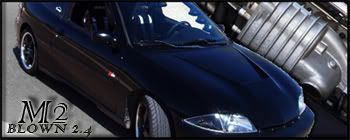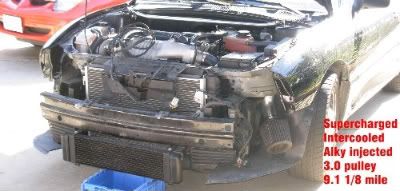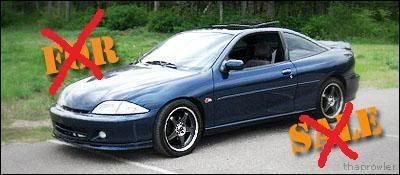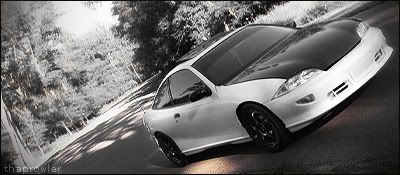i did this write up for my other forum, DesertTuners.com, so i figured id share it with the rest of the j-bo community

Warning! Turbo charging your motor takes a lot of time/work. Do not expect to have it done in a day. Provide yourself ample time & space. It is also wise to have another vehicle incase you need transportation for work, school, parts run ect.
I am in no way responsible for any issues you may encounter while doing it. This is merely a synopsis of the procedure I used. You might run into problems not noted here or find ways that a better/more convenient for you.
To start here is a list of most of the stuff I did/installed in the process of my turbo build;
NEW ENGINE
LUK pro gold stage 2 performance clutch
garrett t3 super 60 turbocharger
str turbo manifold
forge manual boost controller
38 mm external waste gate
tial 6psi waste gate spring
38mm turbo XS stainless steel dump pipe (not ran back into exhaust)
apex-i gt spec front mount intercooler
integrated engineering 2.5inch intercooler piping
braided stainless steel oil lines
earls oil line fittings
greddy type rs style blow off valve
silicone vacuum lines
high flow air filter
brass air-charge sensor
custom 2.5 turbo-to-cat exhaust
apex-i n1 cat back exhaust 2.5 inch
re-routed fuel lines
re-routed coolant line
removed cruise control for turbo clearance
k&n oil filter

As you go through my list you’ll notice that I did not use an engine management system, different injectors, or any aftermarket internals for the engine. For my build the target range I was going for was 4-6psi. Such a little amount of boost does not require aftermarket fuel upgrades. It is recommended, but not necessary. Also i would reccommend a wideband for the tune/ more accurate A/F ratio.
**note** I did my oil lines at the very end incase I ran into problems where the turbo wouldn’t work, that way I could just put all my stock stuff back on.. You may want to do them right after installing the turbocharger, the choice is yours.
Step 1: DEMO!!! Definitely the easiest & most fun part. Well it was the most fun for me at least, I had no directions or run through of how I should do anything so taking @!#$ apart was one of the most productive things I did

What to do… drain oil/coolant. then pull off… complete intake system (from throttle body to inner fender). Exhaust manifold & down pipe. Ignition cover (makes it easier to work around). Cruise control module, I had fitment problems so scrapped it, you can always relocate it but I decided not to. Remove dipstick. (2? small bolts then just slides out with a little force). Remove front bumper.


The first actual part I installed was the turbo manifold. It bolted up no problem and I reused the stock gasket. Gm has a specific way that you’re “supposed” to tighten/remove the bolts. It doesn’t matter. Just hand tighten all, tighten down all, final tighten/torque down bolts. Also, you will have to cut/alter your coolant line that attached to the stock manifold. I simply cut it down and added some head wrap to the line. Never had any issues.



Also while I had the coolant drained I painted/cleaned out my reservoir.



Installation of external waste gate. Its only 2 bolts simply tightened with the appropriate hex fitting. (if you run an internal waste gate you can skip this step. There is a part called a wastegate block off flange that you can purchase from vibrant performance for pretty cheap, simply a steel piece/ gasket that blocks this section off.


Turbocharger installation. bolt both the oil feed/drain pieces to the turbo BEFORE you bolt it on. Will save you a lot of trouble. Apply gasket, both on.


Run your vacuum line from the turbo to the wastegate.


Mount your intercooler. I would recommend doing this before you even try to test kit any charge pipes. Make sure it’s centered where you want it and hidden appropriately. (my intercooler is enormous and hard to hide lol)
You can use all kinds of things to mount it, whether it be clamped, actual mounts made, bolted to the reinforcement bar, or held in place with steel cord to the X-reinforcement bar like I did my first time around haha.

Here are the different sections of pipe I made/used….
Throttle body down



Behind radiator to intercooler.


I had to cut out a piece of plastic for this to sit where I wanted it.


Where the pipes met.


Where it met the intercooler


Now onto the other side of the intercooler. Here was my first pipe

The 90 degree elbow I used and the pipe that went through into the engine bay.

The pipe going to the turbo.


And now the pipe connected to the turbo itself.

The next section of pipe is going from the turbocharger to the air filter. You COULD leave this open if you only plan to use it for race/track use. Otherwise use a filter that way you don’t suck all kinds of crap through the engine under regular driving conditions
I used 2 90degree couplers with a 3(ish)inch piece of pipe in between them for strength

Now run another piece of pipe to where your filter box originally sat and place the filter on the end. Test fit, make sure everything sits correctly.

Choose a suitable place for your blow off valve. This is where I placed mine, it was a simple cut out one piece replace with another for me.

This is where your vacuum line will need to be branched/attached.

Now remove the pipe you would attach your air filter to. Drill a hole/place a rubber grommet for your air charge sensor.

Also place a connection for your manifold vacuum hose, I used a connection off an old intake system for ease && ran in next to my power steering

Oil lines!!! These are kind of important, so don’t cheap out on them. If an oil line fails your turbo could fail, engine could blow, ect ect and your S.O.L.
Stainless steel braided oil lines, earls or comparable fittings. Also misc. fitting from home depot (the ones I received with my feed line were crap, I went to the plumbing section and got all new brass ones).
Here is how you should connect feed line, it also might be a good idea to put a restrictor valve on there so you can regulate the amount of oil going to the turbo.

Connect to the top of the turbocharger.
For the oil return line you want it to run as straight down as possible. Gravity returns the oil to the pan so don’t make a bunch of unnecessary turns. You can either drill the oil pan or run it back through the dipstick. I made a custom dip stick with copper piping because u did not want to drill my pan. Higher boost applications: DRILL YOUR PAN.
Here is the line going down, also a good pic to see the vacuum line attached from the turbo to the wastegate.

A picture of the line with the engine out of the car (the line was shortened again after this pic was taken). In addition, I had the exhaust started and welded to the existing cat/exhaust. (It looks like crap but worked very well lol) the yellow indicated roughly how it was after I fixed the line

While you’re getting the exhaust done you can have the wastegate down pipe ran into the exhaust, or just vent straight down. Again, the choice is yours. I vented mine straight down with this…

Here is my boost controller. It was added later. It replaced the line from the turbo to wastegate. Run the lone from the turbo to the controller then from the controller to the waste gate. Same concept would apply with an internal wastegate instead of an external.
*note* boost controllers can only increase boost. your internal/external wastegate will be set for a certain psi. the lowest you can go is to that original psi level and then increase it from there.


Refill liquids. Make sure boost is set at LOWEST setting. Get tuned. Drive.
End product! Hope this helps a little, im sure I forgot a bunch and will be back in to edit it 400 times haha. So don’t flame me to bad if you think it’s a @!#$ty write up





Eat my shift


































































